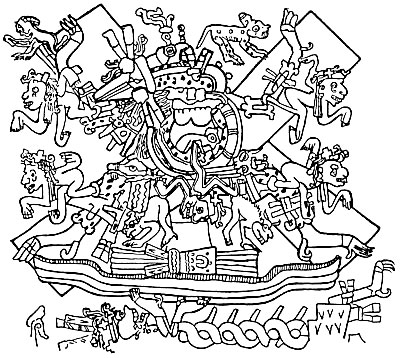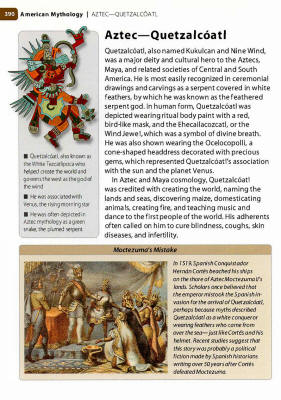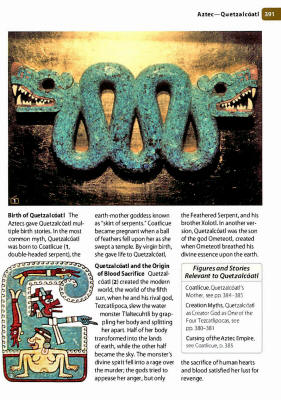|

by Darryl
freethoughtnation
October 20, 2012
from
Planet.Infowars Website
Spanish version

One of the gods highlighted in
The Christ Conspiracy, and
even more so in
Suns of God,
is the Mesoamerican deity Kukulkan or Quetzalcoatl.
In Christ Con, it is included the
fact that mainstream scholarship does not allow for contact between
the “Old” and “New” Worlds, but I suggested that the presence of the
“mythos” or mythical archetype in Mexico centuries before “first
contact” would serve as an indication that there
was pre-Columbian contact.
(However, the core shared traditions may
also predate the first migrations of peoples into the Americas,
possibly traceable to back to Africa or points in between. Some of
these parallels may also emanate from observations of globally
detectable natural phenomena directly from a local perspective.)
After making the above disclaimer, I
commented:
“However it got there, there can be
no doubt as to the tremendous similarity between the Mexican
religion and Catholicism.”
In both books, it is quoted and cited
the abundant scholarship reflecting what the conquistadors/Jesuits
themselves had recounted, common knowledge among modern comparative
religion and Mesoamerican scholars.
Indeed, these correspondences were so
commonly recognized that many natives reportedly converted to
Christianity with relatively little effort
because of the similarities
between their religion and that of the Christians.
As American anthropologist Dr.
C. Scott Littleton (1933-2010)
remarks:
The speed with which many
Mesoamerican people converted to Christianity had much to do
with Quetzalcoatl.
Some people converted because they
identified Cortes with their god;
they believed the new rituals
the Spanish missionaries introduced were another version of
practices used to worship Quetzalcoatl.
This process was aided by a
resemblance between the Spanish missionaries and the Aztec
priests of Tenochtitlan, both of whom wore long black coats.
Other people converted because
they identified Christ with Quetzalcoatl.
Both figures had a message of peace;
in addition, the myth of Quetzalcoatl’s descent into the
underworld to find bones for a future human race, and the use of
his own blood to bring the bones to life, had parallels in the
story of Christ’s crucifixion, death and resurrection.
(Littleton,
Gods,
Goddesses and Mythology, v. 11. New York:
Marshall Cavendish, 2005; p. 1203.)
I continue to explore how this
phenomenon has come to be and to raise this issue of the
Mesoamerican correspondences to Christianity, included in
2012
Astrotheology Calendar:
Like Christ,
Quetzalcoatl is born of a virgin,
the goddess Coatlique, and is a great teacher of civilization.
Also like Jesus, Quetzalcoatl strikes down the Prince of
Darkness and Evil (Tezcatlipoca), who attempts to deceive
mankind.
The Aztec godman descends into the
underworld, where he “gathers the bones of the human beings of
the previous epochs,” while, in the apocryphal text [The Gospel
of Nicodemus], Christ resurrects several kings and prophets of
previous epochs out of the underworld.
Quetzalcoatl’s blood is
used to convey life to the humans whose bones he saved, while
Christ’s blood delivers eternal life and saves humans from
death.
Quetzalcoatl became the “second
sun,” while Jesus is the “sun of righteousness” arising with
healing on his wings. (Mal 4:3) Both Christ and Quetzalcoatl are
identified with the morning star. Quetzalcoatl also represents
one of the four cardinal points, one of four “brothers,” while
Christ has four brothers (Mt 13:55).
Both figures are depicted as
light-skinned and bearded, and it is claimed of both that they
will return to vanquish their enemies.
Jesus came with a sword
and threatened to bring chaos to the earth, while Quetzalcoatl,
“caused a rain of fire to devastate the earth, drying up all the
rivers and destroying man…”
Quetzalcoatl’s acts are also similar
to several of
the Jewish god Yahweh’s in Genesis, for example.
Also like Jesus, who identifies
himself (Jn 3:14-15) with the serpent Moses raised up at Numbers
21:0, Quetzalcoatl and Kukulkan are identified with the serpent,
a relationship dramatically reflected at Kukulkan’s temple at
Chichen Itza.
These contentions are all cited using
modern research such as can be found in
National Geographic - Essential Visual
History of World Mythology (pag. 391 - below images), articles on Wiki,
which have been vetted for accuracy,
and primary sources wherever possible.
 
Virgin Birth?
As concerns the virgin birth, it is
clear that such a concept was understood to have been applied to a
“priest-king” named
Quetzalcoatl.
Based on the
abundantly pervasive concept of the virgin
birth found elsewhere, as well as the fact that kings,
priests and other “authorities” have frequently been identified with
or as gods, it is logical to suggest that the attribute attached to
the supposed “king” Quetzalcoatl was also that of the god.
In
Living Myths -
How Myth Gives Meaning to Human Experience, under
the entry “The Story of Quetzalcoatl: The Hero Becomes a God,”
classical scholar J.F. Bierlein summarizes this issue:
Quetzalcoatl was many things:
-
a historical personage - a
great priest-king and religious reformer who lived in
approximately the tenth century A.D…
-
a god of the winds, the
sun, and the planet Venus
-
the cultural hero and
expected “messiah” of the pre-Columbian Mexicans
-
a god-hero who served as
patron of the arts, writing and the cultivation of maize
These identities
became fused together over time.
Concerning the birth of this composite
figure,
Bierlein further states:
There are several stories regarding
the birth of Quetzalcoatl. One version has him born of a virgin
named Chimalman, to whom the supreme god, Onteotl (the Great
Father-Mother) appeared in a dream. Onteotl showed his/her face
to Chimalman and her two sisters.
The two sisters died instantly from
the gaze, but Chimalman, pure of heart, survived and conceived a
son, Quetzalcoatl. In another version, the virgin Chimalman
swallows a sacred piece of jade and conceives Quetzalcoatl.
A third story of Quetzalcoatl’s birth is
directly tied to his identify as a deity of the sun and planet
Venus.
In this story, Quetzalcoatl is the son
of a mother who already has four thousand children who have left her
and now form the stars of the Milky Way. This mother was saddened to
be alone and have her children so far from her bosom. She began to
weep from longing.
Onteotl took pity on her in her loneliness and
caused a feather of the sacred quetzal bird to drift…
Some of the pertinent information
concerning Quetzalcoatl’s virgin birth can be found in the
Codices Telleriano-Remensis and Vaticanus A,
folio 27v, from a Spanish commentator, Pedro de los Rios.
Once more, many of these commonalities
between Christ and Quetzalcoatl were remarked upon by the first
non-native chroniclers, not a few of whom were so mortified to find
basically their entire religion among the “savages” that they felt
the need to destroy thousands of Mesoamerican writings and
artifacts.
|




